Dell U2412M - 16:10 IPS without Breaking the Bank
by Chris Heinonen on February 28, 2012 9:00 AM ESTDell U2412M Color Quality
With that long write-up out of the way, you might expect that there was something in particular to the U2412M that led me to explain our testing and results. There initially was but it actually proved to be a software issue; still, I thought the explanation on the previous page would be useful for everyone. For our uncalibrated measurements, I used the profile included on the CD, set the brightness to 200 nits, and then measured using the i1Pro meter.
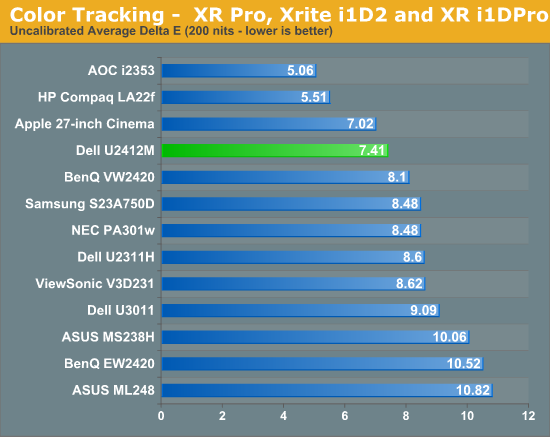
Here we see a score over 7, which is about what we expect to see on a monitor straight out of the box. Comparing this to previous displays isn’t easy to do as most of those used the i1Display2, which isn’t nearly as accurate as the i1Pro is. Of course, all displays do better once calibrated, so I kept the brightness target at 200 nits, with a white point target of D65, gamma of 2.2, and minimum black target.
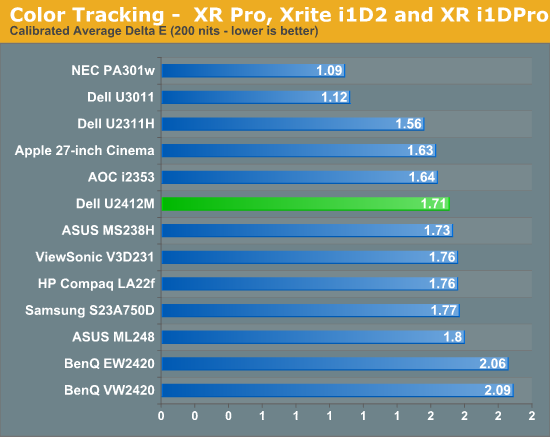
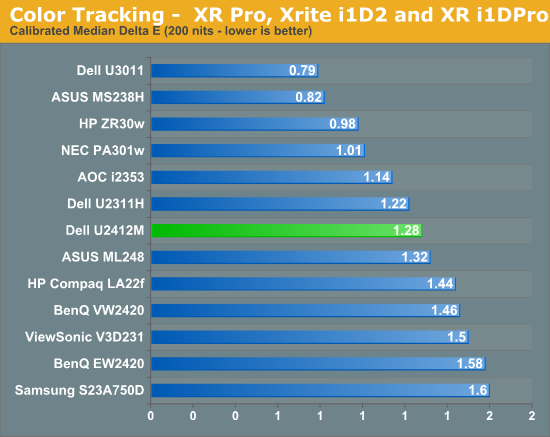
The errors for the Dell look very similar to what we have seen on other monitors. The color gamut is not AdobeRGB, so some of the patches are outside of the range for the display and can’t be rendered correctly. This leads to the spikes in the chart for blue samples and the higher average dE. We included the median dE number so you can see that the value drops quite a bit if we look at that. Everything other than blue is pretty good, and the grayscale is right around 1. So this is nice overall, though not perfectly accurate due to the color gamut and possibly due to the 6-bit panel. Now we will profile again to see if the results are similar with a target of 100 nits instead of 200 nits.
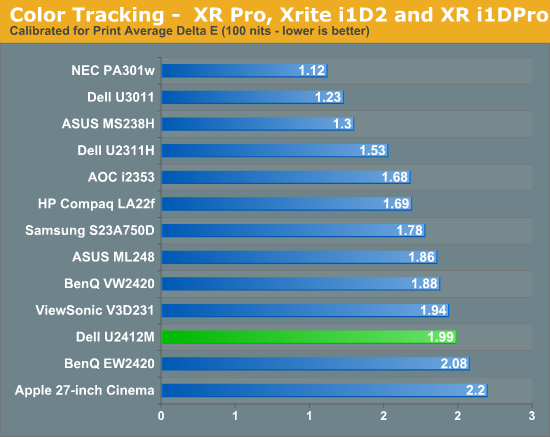
The error seems to rise a bit here, most notably in the grayscale that you would want to keep very neutral for print work. Most colors stay below 3.0 in their error (which is considered the threshold of being visible to the naked eye in motion) but again the blues are past that and errors would be visible to someone that was looking. For serious print work, you probably need to look for something that can use the full AdobeRGB gamut.



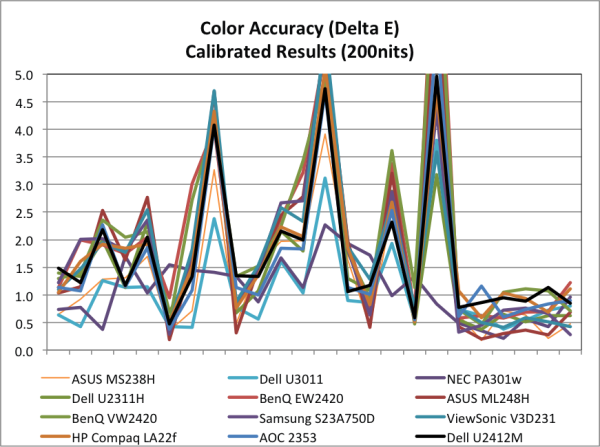
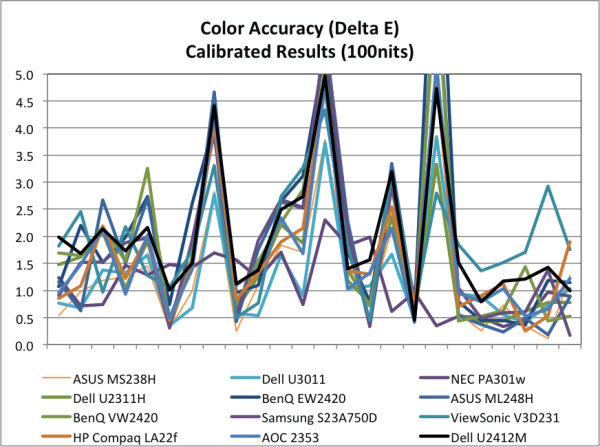








143 Comments
View All Comments
fausto412 - Tuesday, February 28, 2012 - link
Monitor Calibration and ReviewsI see all these monitor reviews where the monitor is calibrated for most accurate colors and blacks and all that...how does a person who bought the monitor go about getting it calibrated? are there local places who do this stuff? when they do it do they save the calibration on your screen?
cheinonen - Wednesday, February 29, 2012 - link
For calibrating the display you need a colorimeter or spetrometer and software. Most include some sort of PC software, or you can use something like DispCalGUI for free. Since these involve using the LUT in your video card, you can't have it done somewhere and then bring it back home, though you could borrow/rent hardware to get it done most likely.For testing, I use an i1Pro for the calibration, which runs around $1,000 new, and an i1DisplayPro for testing the black level (around $300) since it is more accurate at reading low levels of light, but worse at measuring colors. You can use something as simple as an i1DisplayLT, though it will start to drift over time and after 2-3 years you can't rely on it to be accurate anymore and would have to buy another one. The Colormunki series has a spectro that is pretty cheap for use with a monitor, but a cheap spectro is still $400-500 or more.
ggathagan - Wednesday, February 29, 2012 - link
If the big box stores were smart, this is the kind of service they would offer : in-home monitor/TV calibration using a customer's actual setup.hechacker1 - Wednesday, February 29, 2012 - link
They do, THX calibration and whatnot, but they charge an insane amount. Basically, it's better to just buy the colorimeter and do it yourself with various software.It's a good investment if you have many screens. Once you have it, it's a pain to work on any non-calibrated monitor, knowing just how bad it is.
Confusador - Tuesday, February 28, 2012 - link
"...still, I thought the explanation on the previous page would be useful for everyone."It was, thank you for keeping it in. It's always nice to know the rationale behind the testing method.
On a side note, I'm glad to see Dell at least trying to have a reasonably priced 16:10, but it still saddens me that we haven't seen much improvement in monitors (in terms of price/resolution) for so long. I can only dream that with high resolution tablets coming out, we'll see some of that trickle into desktops. For me at least, vertical space is at a premium because I have the horizontal covered by virtue of simply having more than one display.
Impulses - Wednesday, February 29, 2012 - link
I know right? Next gen tablets and phones are running higher resolutions than like 80% of laptops out there, and the average desktop display isn't faring much better. I don't see how market economics are allowing display manufacturers to create these amazing new 10" displays yet desktop displays have languished for so long...ggathagan - Wednesday, February 29, 2012 - link
I doubt you'll ever see that trend in discrete monitors.The entire reason for higher resolutions for a laptop/tablet is due to the physical constraints on the screen size.
If you want a higher resolution for a desktop monitor, you buy a larger monitor.
From a manufacturing standpoint, I would guess that quality control issues increase geometrically when you work with larger physical sizes. It's probably a lot easier to create a high resolution screen at 10 inches than it is at 24 or 27 inches.
Unless there's a compelling reason to do so, I doubt screen manufacturers are eager to take that on.
Far better to concentrate R&D efforts on 120Hz IPS panels and the like.
Zolcos - Wednesday, February 29, 2012 - link
One way you could improve this part of the review is to use the same chart method that you used for power draw -- each monitor having two bars, one for "real world" input lag and one for "worst case" input lag.toyotabedzrock - Wednesday, February 29, 2012 - link
No tests of how it handles color gradients?If we are to pay more for an IPS display then it needs to be 8bit.
MadAd - Wednesday, February 29, 2012 - link
1200 lines is a start, but am still waiting for the ultimate answer to a monitor upgrade24", 120hz, 1200 lines and displayport
is that too much to ask?